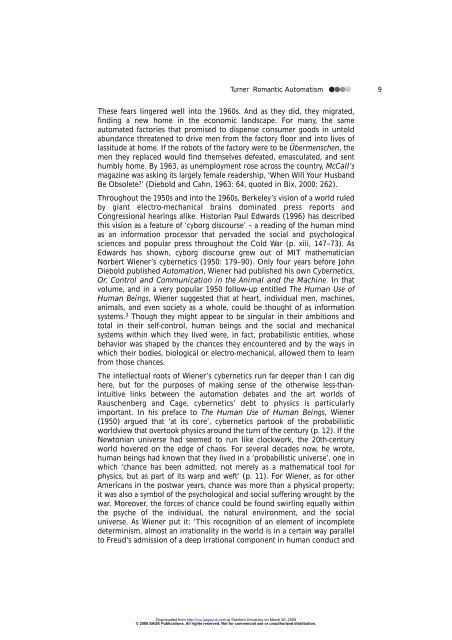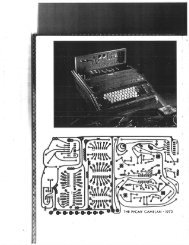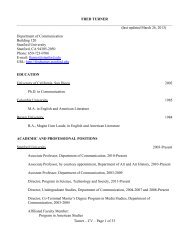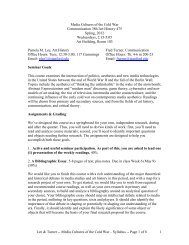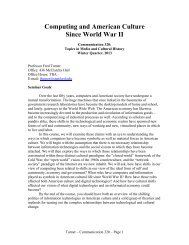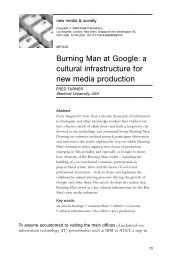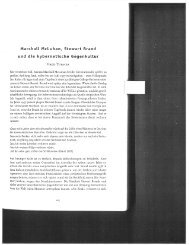Journal of Visual Culture - Fred Turner - Stanford University
Journal of Visual Culture - Fred Turner - Stanford University
Journal of Visual Culture - Fred Turner - Stanford University
You also want an ePaper? Increase the reach of your titles
YUMPU automatically turns print PDFs into web optimized ePapers that Google loves.
<strong>Turner</strong> Romantic Automatism 9<br />
These fears lingered well into the 1960s. And as they did, they migrated,<br />
finding a new home in the economic landscape. For many, the same<br />
automated factories that promised to dispense consumer goods in untold<br />
abundance threatened to drive men from the factory floor and into lives <strong>of</strong><br />
lassitude at home. If the robots <strong>of</strong> the factory were to be Übermenschen, the<br />
men they replaced would find themselves defeated, emasculated, and sent<br />
humbly home. By 1963, as unemployment rose across the country, McCall’s<br />
magazine was asking its largely female readership, ‘When Will Your Husband<br />
Be Obsolete?’ (Diebold and Cahn, 1963: 64, quoted in Bix, 2000: 262).<br />
Throughout the 1950s and into the 1960s, Berkeley’s vision <strong>of</strong> a world ruled<br />
by giant electro-mechanical brains dominated press reports and<br />
Congressional hearings alike. Historian Paul Edwards (1996) has described<br />
this vision as a feature <strong>of</strong> ‘cyborg discourse’ – a reading <strong>of</strong> the human mind<br />
as an information processor that pervaded the social and psychological<br />
sciences and popular press throughout the Cold War (p. xiii, 147–73). As<br />
Edwards has shown, cyborg discourse grew out <strong>of</strong> MIT mathematician<br />
Norbert Wiener’s cybernetics (1950: 179–90). Only four years before John<br />
Diebold published Automation, Wiener had published his own Cybernetics,<br />
Or, Control and Communication in the Animal and the Machine. In that<br />
volume, and in a very popular 1950 follow-up entitled The Human Use <strong>of</strong><br />
Human Beings, Wiener suggested that at heart, individual men, machines,<br />
animals, and even society as a whole, could be thought <strong>of</strong> as information<br />
systems. 3 Though they might appear to be singular in their ambitions and<br />
total in their self-control, human beings and the social and mechanical<br />
systems within which they lived were, in fact, probabilistic entities, whose<br />
behavior was shaped by the chances they encountered and by the ways in<br />
which their bodies, biological or electro-mechanical, allowed them to learn<br />
from those chances.<br />
The intellectual roots <strong>of</strong> Wiener’s cybernetics run far deeper than I can dig<br />
here, but for the purposes <strong>of</strong> making sense <strong>of</strong> the otherwise less-thanintuitive<br />
links between the automation debates and the art worlds <strong>of</strong><br />
Rauschenberg and Cage, cybernetics’ debt to physics is particularly<br />
important. In his preface to The Human Use <strong>of</strong> Human Beings, Wiener<br />
(1950) argued that ‘at its core’, cybernetics partook <strong>of</strong> the probabilistic<br />
worldview that overtook physics around the turn <strong>of</strong> the century (p. 12). If the<br />
Newtonian universe had seemed to run like clockwork, the 20th-century<br />
world hovered on the edge <strong>of</strong> chaos. For several decades now, he wrote,<br />
human beings had known that they lived in a ‘probabilistic universe’, one in<br />
which ‘chance has been admitted, not merely as a mathematical tool for<br />
physics, but as part <strong>of</strong> its warp and weft’ (p. 11). For Wiener, as for other<br />
Americans in the postwar years, chance was more than a physical property;<br />
it was also a symbol <strong>of</strong> the psychological and social suffering wrought by the<br />
war. Moreover, the forces <strong>of</strong> chance could be found swirling equally within<br />
the psyche <strong>of</strong> the individual, the natural environment, and the social<br />
universe. As Wiener put it: ‘This recognition <strong>of</strong> an element <strong>of</strong> incomplete<br />
determinism, almost an irrationality in the world is in a certain way parallel<br />
to Freud’s admission <strong>of</strong> a deep irrational component in human conduct and<br />
Downloaded from<br />
http://vcu.sagepub.com at <strong>Stanford</strong> <strong>University</strong> on March 20, 2008<br />
© 2008 SAGE Publications. All rights reserved. Not for commercial use or unauthorized distribution.


